Symmetry
The Life transition rule, like that of any isotropic cellular automaton, is invariant under reflections and rotations. That is, the change in state of a cell remains the same if its neighbourhood is rotated or reflected. This implies there are symmetries which if present in a pattern are present in all its successors. Note that the converse is not true: a pattern need not have the full symmetry of one of its successor states.
Square-grid symmetries
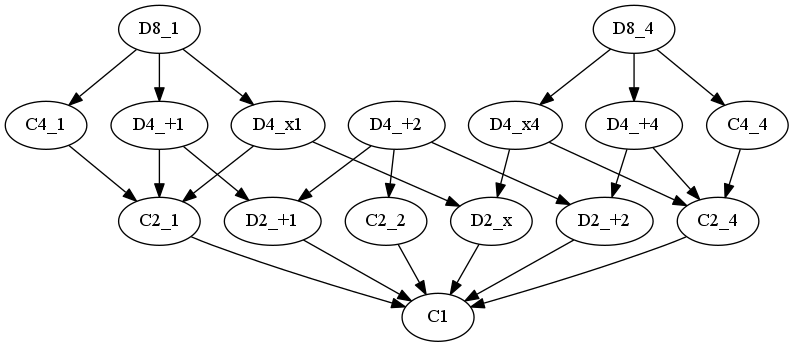
Rotational symmetries
Rotational symmetries include the following (note that "C" refers to the cyclic groups):
C1
C1: Symmetric under 360° rotation. This is essentially no symmetry at all.
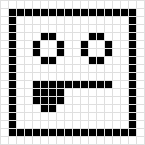 C1 symmetry |
C2
C2: Symmetric under 180° rotation. There are three possibilities:
- C2_1: Rotation around the center of a cell. The bounding rectangle of a C2_1 pattern is odd by odd.
- C2_2: Rotation around the midpoint of a side of a cell. The bounding rectangle is even by odd.
- C2_4: Rotation around a corner of a cell. The bounding rectangle is even by even.
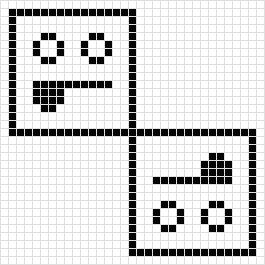 C2_1 symmetry |
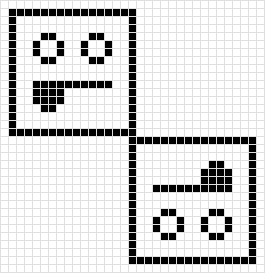 C2_2 symmetry |
 C2_4 symmetry |
C4
C4: Symmetric under 90° rotation. There are two possibilities:
- C4_1: Rotation around the center of a cell. The bounding rectangle is odd by odd.
- C4_4: Rotation around a corner of a cell. The bounding rectangle is even by even.
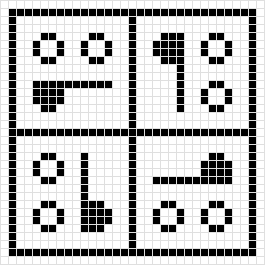 C4_1 symmetry |
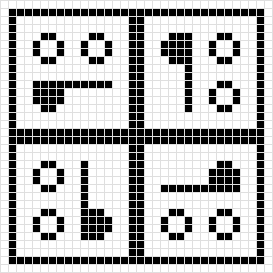 C4_4 symmetry |
Reflectional symmetries
Reflectional symmetries include the following (note that "D" refers to the dihedral groups):
D2
D2: Symmetric under reflection through a line. There are two possibilities:
- D2_+ The line is orthogonal. There are two sub-possibilities:
- D2_+1 The line bisects a row of cells. The bounding rectangle is odd by any.
- D2_+2 The line lies between two rows of cells. The bounding rectangle is even by any.
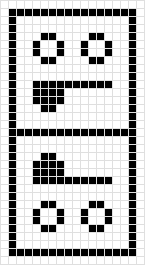 D2_+1 symmetry |
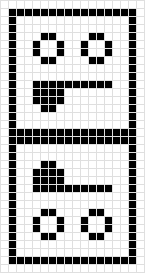 D2_+2 symmetry |
- D2_x The line is diagonal.
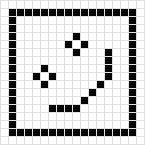 D2_x symmetry |
D4
D4: Symmetric under both reflection and 180° rotation. The reflection symmetry will be with respect to two lines. There are two possibilities:
- D4_+: The lines are orthogonal. There are three sub-possibilities:
- D4_+1: Rotation around the center of a cell. The bounding rectangle is odd by odd.
- D4_+2: Rotation around the midpoint of a side of a cell. The bounding rectangle is even by odd.
- D4_+4: Rotation around a corner of a cell. The bounding rectangle is even by even.
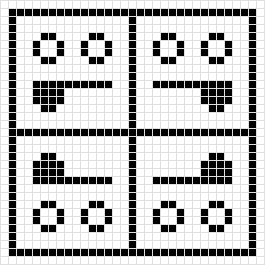 D4_+1 symmetry |
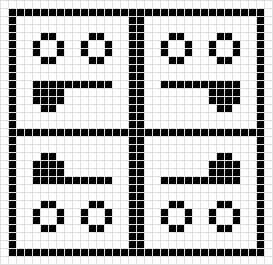 D4_+2 symmetry |
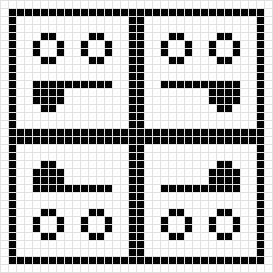 D4_+4 symmetry |
- D4_x The lines are diagonal. There are two sub-possibilities:
- D4_x1: Rotation around the center of a cell. The bounding rectangle is odd by odd.
- D4_x4: Rotation around a corner of a cell. The bounding rectangle is even by even.
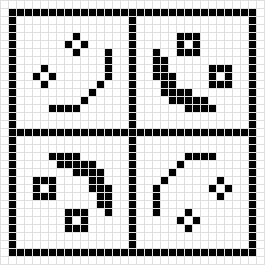 D4_x1 symmetry |
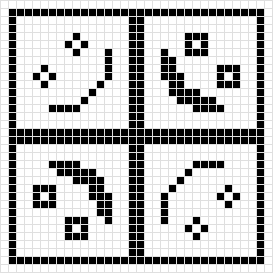 D4_x4 symmetry |
D8
D8: Symmetric under both reflection and 90° rotation. The reflection symmetry will be with respect to horizontal, vertical, and diagonal lines. There are three possibilities:
- D8_1: Rotation around the center of a cell. The bounding rectangle is odd by odd.
- D8_2: Rotation around a edge of a cell. The bounding rectangle is even by odd. This symmetry is not preserved by Life (reverting to D4_+2), but is with most bilaterally symmetric rules.
- D8_4: Rotation around a corner of a cell. The bounding rectangle is even by even.
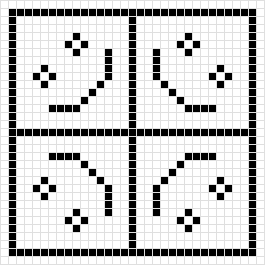 D8_1 symmetry |
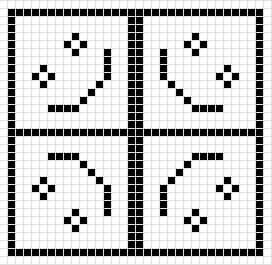 D8_2 symmetry |
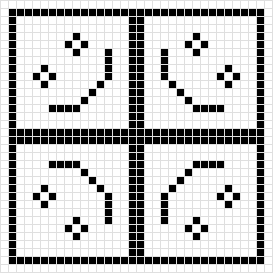 D8_4 symmetry |
To preserve D8_2 symmetry, the following transitions must either all exist simultaneously with all other transitions in the same line or none should:[1]
- B1c/B2c/B4c
- B1e/B2a/B2i/B4i
- B3e/B3j
- B3i/B6i
- B3q/B3y
- B4t/B5r
- B4e/B5y/B4w
- B4a/B5i
- B4n/B5e
- B5a/B7e/B8
- B6c/B6k
- S0/S1e/S3a
- S2c/S2k
- S2i/S5i
- S3e/S4r
- S3i/S4a/S4t/S6a/S6i/S7e
- S3r/S4i
- S3y/S4c/S4q
- S5e/S5j
- S5q/S5y
- S6c/S7c
Skew symmetries
If a pattern exhibits symmetry only after its constituent congruent pieces are offset by certain amounts in one or both orthogonal directions, the pattern is said to exhibit skew symmetry.
Gutter symmetries
Gutter symmetries are distinguished from non-gutter symmetries by the existence of an empty lane of cells – the "gutter" – separating the congruent pieces making up overall pattern.
A pattern that exhibits gutter symmetry only after its pieces are skewed in the above sense is said to exhibit skew-gutter symmetry.
Gutter and skewgutter symmetries are known to exist for both orthogonal and diagonal lines of symmetry.........?
 Orthogonal gutter symmetry D2_+1_gO1S0 |
 Orthogonal skewgutter symmetry D2_+1_gO1S1 |
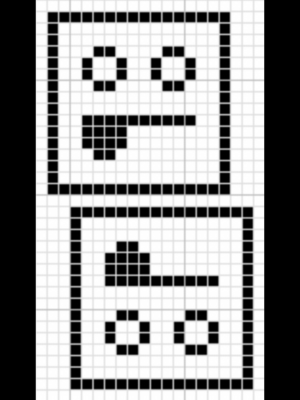 Orthogonal double skewgutter symmetry[2] D2_+1_gO1S2 |
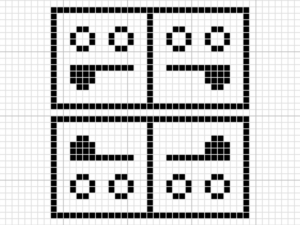 D4_+1 with orthogonal gutter symmetry D4_+1_gO1S0 |
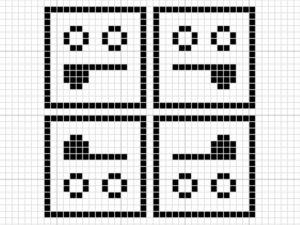 D4_+1 with two orthogonal gutters D4_+1_gO1SO_gO1S0 |
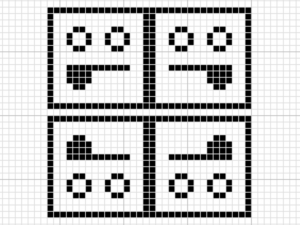 D4_+2 with orthogonal gutter symmetry D4_+2_gO1S0 |
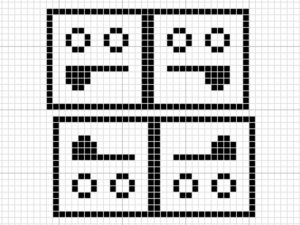 D4_+2 with orthogonal gutter symmetry, skewed |
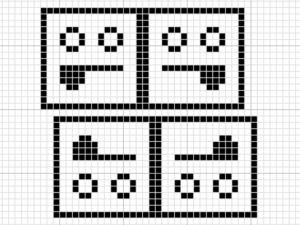 D4_+2 with orthogonal gutter symmetry, doubly skewed |
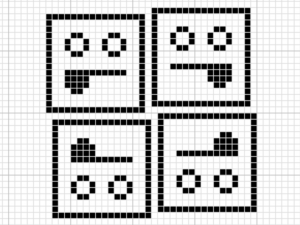 D4_+1 with two skew orthogonal gutters |
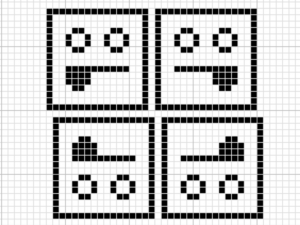 D4_+2 with two orthogonal gutters, one skewed |
 D4_+2 with two orthogonal gutters, one doubly skewed |
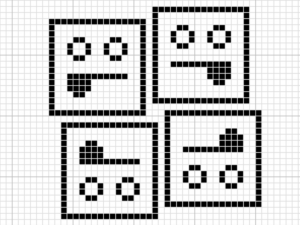 D4_+1 with two double-skew orthogonal gutters |
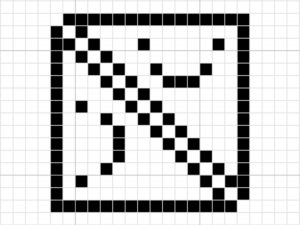 Diagonal gutter symmetry D2_x_gD1S0 |
 Diagonal skewgutter symmetry D2_x_gD1S1 |
 D4_x1 with diagonal gutter symmetry D4_x1_gD1S0 |
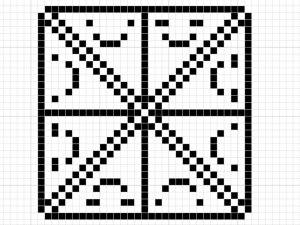 D4_x1 with two diagonal gutters D4_x1_gD1S0_gD1S0 |
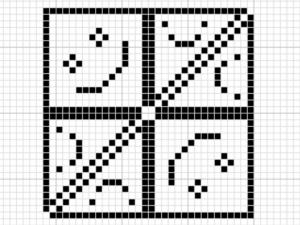 D4_x4 with diagonal gutter symmetry D4_x4_gD1S0 |
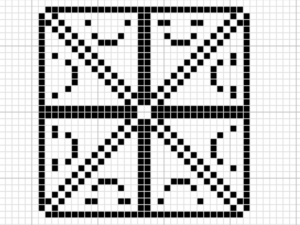 D4_x4 with two diagonal gutters D4_x4_gD1S0_gD1S0 |
 D8_1 with orthogonal gutter symmetry |
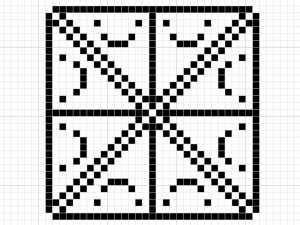 D8_1 with diagonal gutter symmetry |
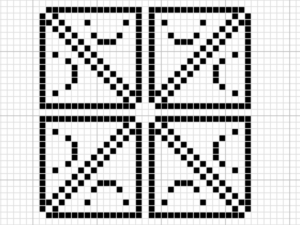 D8_1 with orthogonal and diagonal gutters |
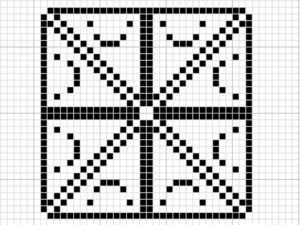 D8_4 with diagonal gutter symmetry |
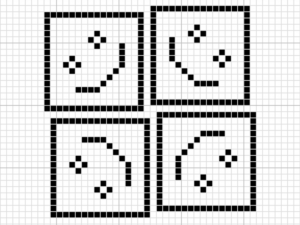 D8_1 with rotationally-symmetric orthogonal skewgutter symmetry |
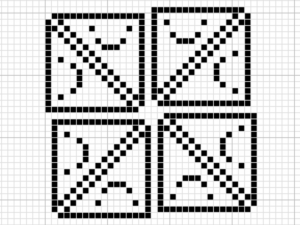 and diagonal gutters |
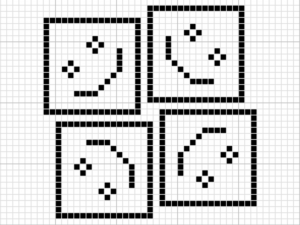 D8_1 with rotationally-symmetric orthogonal double skewgutter symmetry |
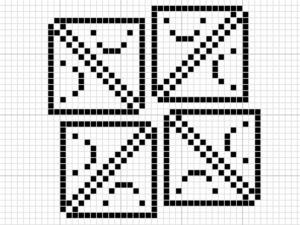 and diagonal gutters |
In order to preserve orthogonal gutter symmetry, the birth conditions B0, B2c, B2i, B4i, B4c and B6i must be absent.
In order to preserve orthogonal skewgutter symmetry, the birth conditions B0, B1c, B2k, B2n, B3n, B3y, B4y, B4z, B5r and B6i must be absent.
In order to preserve orthogonal double skewgutter symmetry, the birth conditions B0, B1c, B1e, B2a, B2i, B2k, B2n, B3c, B3q, B3r, B4c, B4n, B4y, B4z, B5e, B5r and B6i must be absent.
In order to preserve diagonal gutter symmetry, the birth conditions B0, B2n, B2e, B4e, B4w and B6n must be absent.
In order to preserve diagonal skewgutter symmetry, the birth consitions B0, B1c, B1e, B2a, B2k, B3k, B3q and B4q must be absent.
Preserving triple or higher orthogonal skewgutter symmetry in a range-1 Moore rule requires that a pattern must not be able to escape its bounding box.
Compositional/translational symmetry
For certain rules, any pattern completely made of correctly-aligned arrangements of cells that fit within a 2×2 area will always be made up of said 2×2 arrangements of cells in all subsequent generations, simulating a Margolus-neighbourhood rule.[3] One famous example of this is 2×2.
In the case of 2×2's rule, further self-similarity can be noted with certain patterns - anything made of solid 4×4 blocks which are correctly aligned will still be made of 4×4 blocks in even generations, and so on.
apgsearch supports the full block version of these symmetries through the inflation operator.
Oscillator symmetries
Oscillators have a wider range of symmetries than still lifes. This is because an oscillator can appear in two or four congruent states, not necessarily the same. There are 43 possible symmetries of oscillators, 27 of which do not appear in still lifes (i.e. period/mod = 2 or 4). The symmetry class is the symmetry class of the oscillator in a single generation followed by the symmetry class of the union of the generation and its congruent successors.[4]
Spaceship symmetries
Spaceships have a limited range of symmetries because no spaceship can have rotational symmetry. However, spaceships can have glide symmetry, which is not applicable for finite patterns that do not move.
Hexagonal-grid and triangular-grid symmetries
Hexagonal and triangular grids have the same set of admissible symmetries as each other (by planar duality), but these are not the same symmetries as square grids. Due to how hexagonal and triangular grids are handled by programs such as Golly and LifeViewer, they will also appear markedly different in these respects. C2, D2, and D4 symmetries are still compatible, but C4 symmetries become meaningless because the cells no longer have a side count that is perfectly divisible by 4. Other symmetries are exclusive to these alternative grids, as indicated below:
- C1
- C2_1
- C2_4
- C3_1
- C3_3 (unsupported by apgsearch)
- C6
- D2_xo
- D2_x
- D4_x1
- D4_x4
- D6_1
- D6_1o
- D6_3 (unsupported by apgsearch)
- D12
apgsearch currently supports most higher symmetries for hexagonal rules; the rest (C3_3 and D6_3) will be added in a future version.[5]
Hexagonal rules can also support gutter symmetry,[6] however, like with square grid gutters, apgsearch does not currently support searching with these.
Rotational symmetries
Rotational symmetries include the following:
C1
C1: Symmetric under 360° rotation. This is essentially no symmetry at all.
C2
C2: Symmetric under 180° rotation. There are two possibilities:
- C2_1: Rotation around the center of a cell.
- C2_4: Rotation around a corner of a cell.
C3
C3: Symmetric under 120° rotation. There are two possibilities:
- C3_1: Rotation around the center of a cell.
- C3_3: Rotation around a corner of a cell. (unsupported by apgsearch)
C6
C6: Symmetric under 60° rotation.
Reflectional symmetries
Reflectional symmetries include the following:
D2
D2: There is line symmetry. There are two possibilities:
- D2_x: Through the vertices of a cell.
- D2_xo: Through the edges of a cell.
D4
D4: Symmetric under both reflection and 180° rotation. The reflection symmetry will be with respect to two lines. There are two possibilities:
- D4_x1: Rotation around the center of a cell.
- D4_x4: Rotation around the edges of a cell.
D6
D6: Symmetric under both reflection and 120° rotation. The reflection symmetry will be with respect to three lines. There are three possibilities:
- D6_1: Rotation around the center of a cell with lines going through the edges of cells.
- D6_1o: Rotation around the center of a cell with lines going through the centers of cells.
- D6_3: Rotation around the corner of a cell. (unsupported by apgsearch)
D12
D12: Symmetric under both reflection and 60° rotation. The reflection symmetry will be with respect to six lines.
References
- BlinkerSpawn (March 19, 2016). Truly Bilateral Life-Like rules (discussion thread) at the ConwayLife.com forums
- muzik (November 30, 2018). Re: Rules with interesting dynamics (discussion thread) at the ConwayLife.com forums
- Aidan F. Pierce (January 8, 2018). Re: Rules with interesting dynamics (discussion thread) at the ConwayLife.com forums
- Dean Hickerson's oscillator stamp collection. Retrieved on May 2, 2019.
- Adam P. Goucher (December 20, 2018). Re: apgsearch v4.0 (discussion thread) at the ConwayLife.com forums
- muzik (December 5, 2018). Re: Non-totalistic hex rules (discussion thread) at the ConwayLife.com forums
External links
- Symmetric at the Life Lexicon
- Help with symmetries (discussion thread) at the ConwayLife.com forums